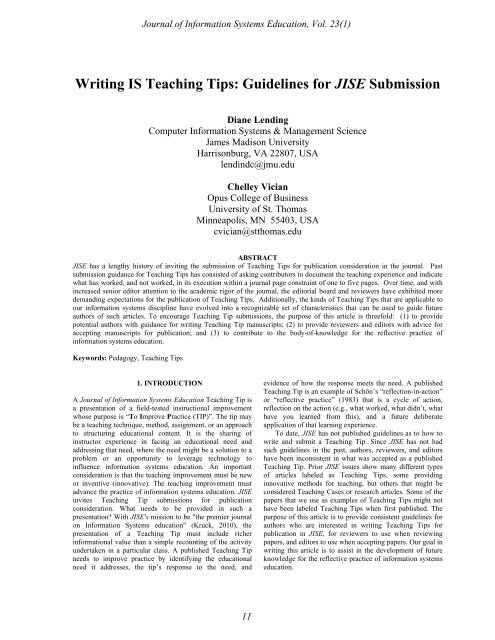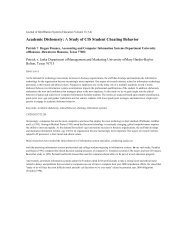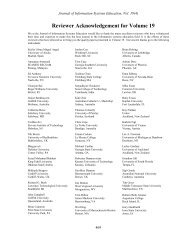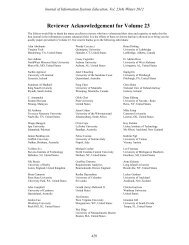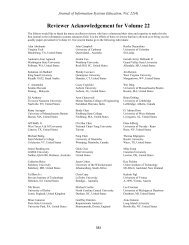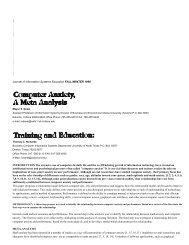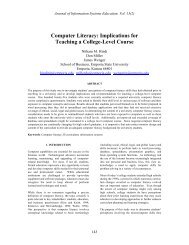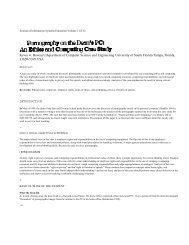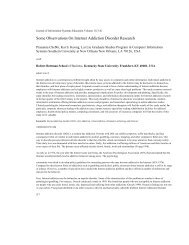Writing IS Teaching Tips - Journal of Information Systems Education
Writing IS Teaching Tips - Journal of Information Systems Education
Writing IS Teaching Tips - Journal of Information Systems Education
Create successful ePaper yourself
Turn your PDF publications into a flip-book with our unique Google optimized e-Paper software.
<strong>Writing</strong> <strong>IS</strong> <strong>Teaching</strong> <strong>Tips</strong>: Guidelines for J<strong>IS</strong>E Submission<br />
Diane Lending<br />
Computer <strong>Information</strong> <strong>Systems</strong> & Management Science<br />
James Madison University<br />
Harrisonburg, VA 22807, USA<br />
lendindc@jmu.edu<br />
Chelley Vician<br />
Opus College <strong>of</strong> Business<br />
University <strong>of</strong> St. Thomas<br />
Minneapolis, MN 55403, USA<br />
cvician@stthomas.edu<br />
ABSTRACT<br />
J<strong>IS</strong>E has a lengthy history <strong>of</strong> inviting the submission <strong>of</strong> <strong>Teaching</strong> <strong>Tips</strong> for publication consideration in the journal. Past<br />
submission guidance for <strong>Teaching</strong> <strong>Tips</strong> has consisted <strong>of</strong> asking contributors to document the teaching experience and indicate<br />
what has worked, and not worked, in its execution within a journal page constraint <strong>of</strong> one to five pages. Over time, and with<br />
increased senior editor attention to the academic rigor <strong>of</strong> the journal, the editorial board and reviewers have exhibited more<br />
demanding expectations for the publication <strong>of</strong> <strong>Teaching</strong> <strong>Tips</strong>. Additionally, the kinds <strong>of</strong> <strong>Teaching</strong> <strong>Tips</strong> that are applicable to<br />
our information systems discipline have evolved into a recognizable set <strong>of</strong> characteristics that can be used to guide future<br />
authors <strong>of</strong> such articles. To encourage <strong>Teaching</strong> Tip submissions, the purpose <strong>of</strong> this article is threefold: (1) to provide<br />
potential authors with guidance for writing <strong>Teaching</strong> Tip manuscripts; (2) to provide reviewers and editors with advice for<br />
accepting manuscripts for publication; and (3) to contribute to the body-<strong>of</strong>-knowledge for the reflective practice <strong>of</strong><br />
information systems education.<br />
Keywords: Pedagogy, <strong>Teaching</strong> <strong>Tips</strong><br />
<strong>Journal</strong> <strong>of</strong> <strong>Information</strong> <strong>Systems</strong> <strong>Education</strong>, Vol. 23(1)<br />
1. INTRODUCTION<br />
A <strong>Journal</strong> <strong>of</strong> <strong>Information</strong> <strong>Systems</strong> <strong>Education</strong> <strong>Teaching</strong> Tip is<br />
a presentation <strong>of</strong> a field-tested instructional improvement<br />
whose purpose is “To Improve Practice (TIP)”. The tip may<br />
be a teaching technique, method, assignment, or an approach<br />
to structuring educational content. It is the sharing <strong>of</strong><br />
instructor experience in facing an educational need and<br />
addressing that need, where the need might be a solution to a<br />
problem or an opportunity to leverage technology to<br />
influence information systems education. An important<br />
consideration is that the teaching improvement must be new<br />
or inventive (innovative). The teaching improvement must<br />
advance the practice <strong>of</strong> information systems education. J<strong>IS</strong>E<br />
invites <strong>Teaching</strong> Tip submissions for publication<br />
consideration. What needs to be provided in such a<br />
presentation? With J<strong>IS</strong>E's mission to be "the premier journal<br />
on <strong>Information</strong> <strong>Systems</strong> education" (Kruck, 2010), the<br />
presentation <strong>of</strong> a <strong>Teaching</strong> Tip must include richer<br />
informational value than a simple recounting <strong>of</strong> the activity<br />
undertaken in a particular class. A published <strong>Teaching</strong> Tip<br />
needs to improve practice by identifying the educational<br />
need it addresses, the tip’s response to the need, and<br />
11<br />
evidence <strong>of</strong> how the response meets the need. A published<br />
<strong>Teaching</strong> Tip is an example <strong>of</strong> Schön’s “reflection-in-action”<br />
or “reflective practice” (1983) that is a cycle <strong>of</strong> action,<br />
reflection on the action (e.g., what worked, what didn’t, what<br />
have you learned from this), and a future deliberate<br />
application <strong>of</strong> that learning experience.<br />
To date, J<strong>IS</strong>E has not published guidelines as to how to<br />
write and submit a <strong>Teaching</strong> Tip. Since J<strong>IS</strong>E has not had<br />
such guidelines in the past, authors, reviewers, and editors<br />
have been inconsistent in what was accepted as a published<br />
<strong>Teaching</strong> Tip. Prior J<strong>IS</strong>E issues show many different types<br />
<strong>of</strong> articles labeled as <strong>Teaching</strong> <strong>Tips</strong>, some providing<br />
innovative methods for teaching, but others that might be<br />
considered <strong>Teaching</strong> Cases or research articles. Some <strong>of</strong> the<br />
papers that we use as examples <strong>of</strong> <strong>Teaching</strong> <strong>Tips</strong> might not<br />
have been labeled <strong>Teaching</strong> <strong>Tips</strong> when first published. The<br />
purpose <strong>of</strong> this article is to provide consistent guidelines for<br />
authors who are interested in writing <strong>Teaching</strong> <strong>Tips</strong> for<br />
publication in J<strong>IS</strong>E, for reviewers to use when reviewing<br />
papers, and editors to use when accepting papers. Our goal in<br />
writing this article is to assist in the development <strong>of</strong> future<br />
knowledge for the reflective practice <strong>of</strong> information systems<br />
education.
2. BACKGROUND<br />
The sharing <strong>of</strong> educational improvements through<br />
acknowledged academic journals is not unique to the<br />
information systems discipline. Our business colleagues in<br />
management, marketing, and accounting have a substantial<br />
history <strong>of</strong> publishing work related to improving the quality<br />
<strong>of</strong> education in each <strong>of</strong> these disciplinary areas. More<br />
recently, educators in the decision sciences area have also<br />
gained a discipline-specific journal for educational-focused<br />
resources. A sampling <strong>of</strong> such disciplinary-specific journal<br />
outlets includes: Issues in Accounting <strong>Education</strong>, <strong>Journal</strong> <strong>of</strong><br />
Accounting <strong>Education</strong>, <strong>Journal</strong> <strong>of</strong> Management <strong>Education</strong>,<br />
Academy <strong>of</strong> Management Learning and <strong>Education</strong>, <strong>Journal</strong><br />
<strong>of</strong> Marketing <strong>Education</strong>, and Decision Sciences <strong>Journal</strong> <strong>of</strong><br />
Innovative <strong>Education</strong>. In addition to the disciplinaryspecific<br />
journals, there is also the <strong>Journal</strong> <strong>of</strong> <strong>Education</strong> for<br />
Business that indicates it “<strong>of</strong>fers a forum for authors<br />
reporting on new successful teaching methods and<br />
curricula,” (<strong>Journal</strong> <strong>of</strong> <strong>Education</strong> for Business website, 2012)<br />
though recent issues did not show evidence <strong>of</strong> such<br />
published work. In most <strong>of</strong> these examples, published<br />
resources aimed at improving the quality <strong>of</strong> general business<br />
or disciplinary-specific education included: a description <strong>of</strong><br />
the idea, a theory or practice context for the idea, a detailed<br />
discussion <strong>of</strong> the idea so that others can replicate it, and a<br />
discussion <strong>of</strong> the evidence for the efficacy <strong>of</strong> the idea.<br />
Further, each academic journal provides advice to potential<br />
manuscript authors regarding expected content and<br />
formatting rather than leaving this decision to the operations<br />
<strong>of</strong> the journal’s editorial board.<br />
Although the information systems academic community<br />
has several education-related conferences (e.g., <strong>IS</strong>ECON,<br />
IAIM) and continuing tracks at its major academic<br />
conferences (e.g., IC<strong>IS</strong>, AMC<strong>IS</strong>, PAC<strong>IS</strong>, EC<strong>IS</strong>) and several<br />
regional conferences (e.g., Midwest A<strong>IS</strong>, Southern A<strong>IS</strong>),<br />
there are few permanent, easily accessible, and dedicated<br />
repositories for information systems instructional<br />
improvements. The Association for <strong>Information</strong> <strong>Systems</strong><br />
website has attempted to provide access to useful and<br />
academically-reviewed teaching resources, though this effort<br />
has been coordinated through a network <strong>of</strong> volunteers and<br />
has proven difficult to maintain over time. Past resources<br />
were hosted at Grand Valley State University through the<br />
efforts <strong>of</strong> Dr. Simha Magal; a current initiative by A<strong>IS</strong>-<br />
SIGEd/IAIM volunteers is still in process. J<strong>IS</strong>E provides<br />
one <strong>of</strong> the few archival, academic, peer-reviewed journal<br />
outlets for such teaching and learning scholarship focused on<br />
the information systems area.<br />
<strong>Teaching</strong> <strong>Tips</strong> submitted to J<strong>IS</strong>E have reported on many<br />
different types <strong>of</strong> improvements. Some are project-based and<br />
suggest assignments for a specific course or courses (e.g.,<br />
Chen & Brabstone, 2010 or Liu & Downing, 2010). Some<br />
introduce a technique that can be used in a number <strong>of</strong><br />
courses (e.g., Whisenand and Dunphy, 2010). Some<br />
introduce a technology (e.g., Dunlap & Lowenthal, 2009). In<br />
this section we provide an overview <strong>of</strong> what makes a<br />
<strong>Teaching</strong> Tip a <strong>Teaching</strong> Tip and what makes it suitable for<br />
publication in J<strong>IS</strong>E. We also discuss the purpose <strong>of</strong><br />
publishing <strong>Teaching</strong> <strong>Tips</strong> in J<strong>IS</strong>E and the motivation for<br />
writing a <strong>Teaching</strong> Tip.<br />
<strong>Journal</strong> <strong>of</strong> <strong>Information</strong> <strong>Systems</strong> <strong>Education</strong>, Vol. 23(1)<br />
2.1 What makes a <strong>Teaching</strong> Tip a <strong>Teaching</strong> Tip?<br />
We first must distinguish a <strong>Teaching</strong> Tip submission from<br />
other types <strong>of</strong> articles published in J<strong>IS</strong>E. Weimer (2006)<br />
provides a helpful dichotomy <strong>of</strong> scholarship in the teaching<br />
and learning field by categorizing such scholarship as either<br />
being wisdom-<strong>of</strong>-practice scholarship or research<br />
scholarship. Wisdom-<strong>of</strong>-practice scholarship is based upon<br />
experience in instruction. Weimer (2006) calls this the howto-literature<br />
<strong>of</strong> teaching. <strong>Teaching</strong> <strong>Tips</strong> fall into this<br />
category. Research scholarship is a more typical type <strong>of</strong><br />
scholarly research using quantitative, qualitative, or<br />
descriptive forms <strong>of</strong> research. In this type <strong>of</strong> scholarship,<br />
surveys and experiments on information systems educational<br />
methods are common examples.<br />
The distinction between these two categories is not<br />
always clear. A good <strong>Teaching</strong> Tip includes evidence that<br />
the improvement worked. If that evidence is provided by a<br />
survey, is it still a <strong>Teaching</strong> Tip? The answer to that question<br />
is based upon emphasis. If the emphasis in the paper is on<br />
the teaching and/or learning improvement with a detailed<br />
description <strong>of</strong> the improvement in such a way that another<br />
instructor could adopt or adapt the idea, it falls into the<br />
<strong>Teaching</strong> Tip category. Such a paper would include example<br />
exercises, methods <strong>of</strong> using the idea, and guidance on how to<br />
adopt the idea. On the other hand, if the emphasis <strong>of</strong> the<br />
paper is on the evidence collection and analysis <strong>of</strong> the<br />
evidence, it falls into the research scholarship category and<br />
thus is not a <strong>Teaching</strong> Tip. As an example, contrast two J<strong>IS</strong>E<br />
papers: a <strong>Teaching</strong> Tip, Lending (2010) and a research<br />
paper, Part, et al. (2010). Both papers are about introducing<br />
Wiki technology into a course and both include evidence <strong>of</strong><br />
how it worked. The <strong>Teaching</strong> Tip focuses on how to<br />
introduce a particular Wiki assignment into a course. The<br />
research paper focuses on the methodology and analysis <strong>of</strong><br />
Wiki technology in graduate education outcomes.<br />
Secondly, we must distinguish <strong>Teaching</strong> <strong>Tips</strong> from<br />
<strong>Teaching</strong> Cases. A <strong>Teaching</strong> Case is based upon a real-world<br />
or real-world-type situation. It provides a case that students<br />
can analyze or a problem that they can solve. Cappel and<br />
Schwager (2002) classified <strong>Teaching</strong> Cases into two<br />
different types: non-project-based cases and project-based<br />
cases. The non-project-based cases are discussion-based and<br />
typically provide questions for students to answer. Often<br />
they ask students to take the role <strong>of</strong> a decision-maker in an<br />
organization. Non-project-based cases are used by many<br />
business disciplines and resemble the Harvard or Ivey cases<br />
<strong>of</strong>ten used in advanced undergraduate and graduate business<br />
education. Project-based cases are categorized as "systems<br />
solution cases" (Cappel & Schwager, 2002). In these cases,<br />
students create an information systems solution which may<br />
include models, documentation, or working systems. This<br />
type <strong>of</strong> case is more typical in the information systems<br />
discipline than other business disciplines, as information<br />
systems practitioners are quite active in building such<br />
artifacts for use in organizations.<br />
A <strong>Teaching</strong> Tip may also present a real-world case or<br />
situation to be solved. The distinction between a tip and a<br />
case can be subtle but again is based upon emphasis and<br />
presentation. A <strong>Teaching</strong> Case emphasizes the actual<br />
business problem that you want students to solve. The<br />
published portion <strong>of</strong> a <strong>Teaching</strong> Case describes the real<br />
12
<strong>Journal</strong> <strong>of</strong> <strong>Information</strong> <strong>Systems</strong> <strong>Education</strong>, Vol. 23(1)<br />
world situation in a form that can be passed out to students.<br />
The case also includes teaching notes describing teaching<br />
suggestions, discussion questions, and possible solutions to<br />
the questions/exercises but these are unpublished and<br />
available only to verified instructors. On the other hand, a<br />
<strong>Teaching</strong> Tip emphasizes the teaching- or learning- need and<br />
solution: what is the instructional situation and how can we<br />
address it? It provides evidence that the solution meets an<br />
instructional need and a reflective discussion <strong>of</strong> what might<br />
be done in the future to change things or adapt the idea for<br />
different audiences or situations. <strong>Teaching</strong> guidelines are an<br />
important part <strong>of</strong> the published tip. Unpublished solutions<br />
may also be appropriate for a <strong>Teaching</strong> Tip and are strongly<br />
encouraged for an assignment tip. As an example <strong>of</strong> the<br />
difference contrast two J<strong>IS</strong>E papers: a <strong>Teaching</strong> Tip, Bunch<br />
(2011) and a <strong>Teaching</strong> Case, Guidry and Tutarro. (2010).<br />
Both present a short fictional business problem that can be<br />
used in instruction. The published <strong>Teaching</strong> Tip presents<br />
context about the instructional situation and how this<br />
assignment can be used. The published portion <strong>of</strong> the<br />
<strong>Teaching</strong> Case focuses on the business situation.<br />
2.2 What makes a <strong>Teaching</strong> Tip suitable for J<strong>IS</strong>E?<br />
To be suitable for J<strong>IS</strong>E, the <strong>Teaching</strong> Tip must go beyond<br />
what McKinney (2007) calls the "I tried it and I liked it<br />
genre". The author(s) cannot simply present an improvement<br />
and say it worked. A good <strong>Teaching</strong> Tip submission presents<br />
a need and an innovative solution. The article should<br />
provide:<br />
A description <strong>of</strong> the teaching- or learning-need.<br />
A concrete description <strong>of</strong> the teaching<br />
improvement and how it can be introduced into a<br />
teaching situation. The description is detailed<br />
enough so that it can be replicated in another<br />
teaching situation by another instructor. The<br />
description also makes it clear how this solution is<br />
innovative.<br />
A theory, literature, or practice based justification<br />
for this need, idea or solution.<br />
Results from field-testing (e.g., in the classroom.)<br />
Evidence that the innovation works.<br />
More detailed guidelines can be found in later sections <strong>of</strong><br />
this paper.<br />
2.3 Motivation for writing and publishing <strong>Teaching</strong> <strong>Tips</strong><br />
The purpose <strong>of</strong> the J<strong>IS</strong>E is to focus on topics <strong>of</strong> interest to <strong>IS</strong><br />
educators (J<strong>IS</strong>E, 2012.) A <strong>Teaching</strong> Tip can be considered a<br />
visible dialog between <strong>IS</strong> educators. The tip presents a<br />
teaching- or learning-need and a solution for that identified<br />
need. It provides guidance on how to implement the solution.<br />
Facilitating that dialog is viewed as part <strong>of</strong> the mission <strong>of</strong><br />
J<strong>IS</strong>E.<br />
For the author <strong>of</strong> a <strong>Teaching</strong> Tip, writing the tip is a way<br />
to focus on a need faced in day-to-day teaching<br />
responsibilities. In developing the rigor necessary to publish<br />
a <strong>Teaching</strong> Tip in a premier journal, one thinks more deeply<br />
about one’s teaching avocation. Grounding the <strong>Teaching</strong> Tip<br />
in learning theory or discipline-specific theory, literature, or<br />
“best practices” suggests that the author is improving his/her<br />
teaching expertise based upon existing knowledge. The<br />
author becomes involved in conversation about teaching with<br />
13<br />
others in the discipline, and as noted by Schön (1983) and<br />
Dewey (1933) before him, begin to integrate both theory and<br />
practice into a continuous learning cycle to develop new<br />
knowledge for practice. Just as writing research papers<br />
places the writer in a dialog with other “experts”, in order to<br />
advance the practice <strong>of</strong> research on a particular topic, so to<br />
does the writing <strong>of</strong> a <strong>Teaching</strong> Tip.<br />
One common warning about working in the field <strong>of</strong><br />
scholarship <strong>of</strong> teaching and learning is that not all<br />
institutions consider such research as substantial research,<br />
i.e., research that contributes to promotion and tenure<br />
decisions (McKinney, 2007.). However, the components <strong>of</strong><br />
an academic career are <strong>of</strong>ten compared to a three-legged<br />
stool with teaching, research, and service forming the three<br />
legs. <strong>Writing</strong> a <strong>Teaching</strong> Tip reinforces all three legs:<br />
improves your teaching, contributes to the knowledge <strong>of</strong><br />
discipline-specific educational practice, and provides service<br />
to one’s colleagues and disciplinary field. An argument can<br />
be made that a peer-reviewed, published <strong>Teaching</strong> Tip in<br />
J<strong>IS</strong>E contributes to the body-<strong>of</strong>-knowledge related to the<br />
quality <strong>of</strong> information systems education, and in that sense,<br />
is an example <strong>of</strong> applied business research. However, if the<br />
published <strong>Teaching</strong> Tip is not viewed as substantial evidence<br />
for the research leg at one’s institution, the published<br />
<strong>Teaching</strong> Tip can provide evidence for the author’s<br />
contributions to teaching and service. Having a peerreviewed<br />
<strong>Teaching</strong> Tip published in J<strong>IS</strong>E is evidence that the<br />
author’s teaching improvement was considered noteworthy<br />
and innovative. The <strong>Teaching</strong> Tip was published through a<br />
double-blind, academic peer review. Additionally with the<br />
publication <strong>of</strong> the tip, the author is providing a solution to a<br />
teaching need for others thus providing a service to one’s<br />
colleagues in the field.<br />
3. TEACHING TIP CATEGORIES<br />
There are many different types <strong>of</strong> <strong>Teaching</strong> <strong>Tips</strong> that are<br />
appropriate for submission to J<strong>IS</strong>E. Categorizing these tips<br />
can be done in two dimensions: type and duration. Tip types<br />
can be categorized as a recommended assignment, teaching<br />
practice, method <strong>of</strong> covering specific content, or a<br />
technology. The first three <strong>of</strong> these are based upon Weimer's<br />
categorization <strong>of</strong> wisdom-<strong>of</strong>-practice scholarship (Weimer,<br />
2006.) The fourth type is an important aspect <strong>of</strong> information<br />
systems education. Each type is described below with<br />
examples given. Any one <strong>Teaching</strong> Tip may encompass<br />
multiple types.<br />
Duration <strong>of</strong> the improvement may vary from an<br />
assignment used in a single instructional session, projects<br />
that are used over several weeks, a technique to structure a<br />
course, or methods used across several courses. Examples <strong>of</strong><br />
each are provided below.<br />
3.1 Recommended Assignment<br />
Many <strong>Teaching</strong> <strong>Tips</strong> take the form <strong>of</strong> reporting on a<br />
recommended assignment whether it is a single session<br />
exercise, a homework assignment, a longer project, or a short<br />
case. In this type <strong>of</strong> <strong>Teaching</strong> Tip, the authors describe an<br />
assignment that they have used in the instructional session<br />
with enough detail that the reader could replicate it or<br />
modify it for use in their own situation. Examples <strong>of</strong> such
tips in J<strong>IS</strong>E are suggesting two projects for use in a data<br />
communications course (Chen and Bradston, 2011),<br />
providing a Java Bean programming assignment (Mitri<br />
2010), using cascading style sheets to design a fly-out menu<br />
(Liu & Downing, 2010) and using a Wiki study-guide<br />
project in an introductory information systems (Lending,<br />
2010).<br />
To be a good assignment <strong>Teaching</strong> Tip, the tip must<br />
meet all the characteristics <strong>of</strong> a good tip in the next section.<br />
In particular it should report on a concrete assignment in a<br />
way that others could adopt it. The actual assignment can be<br />
provided as a figure or an appendix (e.g., Lending 2010.)<br />
The author may also wish to provide solutions to the<br />
assignment which should not be published. For example, a<br />
programming assignment <strong>Teaching</strong> Tip had solutions that<br />
were not published in the journal but are available to<br />
instructors (Mitri, 2010).<br />
This type <strong>of</strong> <strong>Teaching</strong> Tip can be similar to a <strong>Teaching</strong><br />
Case. The difference is one <strong>of</strong> purpose: a <strong>Teaching</strong> Case<br />
provides a substantial business problem that can be handed<br />
out to students; a <strong>Teaching</strong> Tip provides an innovative<br />
solution to a teaching need. The emphasis <strong>of</strong> the tip is on the<br />
improvement and how it is implemented in an instructional<br />
situation.<br />
3.2 Recommended <strong>Teaching</strong> Practice<br />
Other <strong>Teaching</strong> <strong>Tips</strong> introduce a teaching method or<br />
technique. The authors <strong>of</strong>fer advice based upon their own<br />
experience. The techniques should be specific improvements<br />
that are appropriate in information systems education.<br />
Examples <strong>of</strong> such tips are the use <strong>of</strong> crossword puzzles to<br />
teach vocabulary (Whisenand & Dunphy, 2010), the use <strong>of</strong><br />
comment-first-coding to teach programming (Sengupta,<br />
2009), and two approaches to reducing cognitive overload in<br />
teaching database (Bunch, 2009).<br />
This type <strong>of</strong> <strong>Teaching</strong> Tip is usually grounded in a need<br />
that is encountered in many courses. The need is described in<br />
detail. Examples <strong>of</strong> assignments or methods <strong>of</strong> creating<br />
assignments (e.g., Bunch, 2009) are helpful in these tips.<br />
Presenting a theory base as to why this solution meets the<br />
instructional need is a critical piece <strong>of</strong> this type <strong>of</strong> tip (e.g.,<br />
Bloom's taxonomy in Whisenand & Dunphy, 2010 and<br />
visualization in Sengupta, 2009).<br />
3.3 Recommended method <strong>of</strong> covering content<br />
The <strong>Teaching</strong> <strong>Tips</strong> that recommend a method <strong>of</strong> covering<br />
specific content are focused on how to cover a content area,<br />
usually in a specific course. The authors may <strong>of</strong>fer<br />
techniques, assignments, or technologies to cover that<br />
content. In this instance, this type <strong>of</strong> <strong>Teaching</strong> Tip may also<br />
fit into one <strong>of</strong> the other three types <strong>of</strong> <strong>Teaching</strong> <strong>Tips</strong>.<br />
Previously-published examples <strong>of</strong> this category are an<br />
introduction to a server virtualization tool that can be used to<br />
give students real-world experience in enterprise-level<br />
DBMS, (Wagner & Pant, 2010), making Web 2.0 technology<br />
meaningful to students (Lending, 2010,) or how to<br />
demonstrate public key encryption in a meaningful way<br />
(Pendegraft, 2009.)<br />
Other recommended methods <strong>of</strong> covering content can<br />
provide structure for an entire course or group <strong>of</strong> courses.<br />
One example <strong>of</strong> this is found in Peace (2011) who suggests<br />
<strong>Journal</strong> <strong>of</strong> <strong>Information</strong> <strong>Systems</strong> <strong>Education</strong>, Vol. 23(1)<br />
using debates as a method <strong>of</strong> teaching information systems<br />
ethics.<br />
Like recommended practice <strong>Teaching</strong> <strong>Tips</strong>, these tips are<br />
usually grounded in a specific need or needs that are faced in<br />
the instructional situation. However these tips focus on the<br />
content area <strong>of</strong> a specific course. In these <strong>Teaching</strong> <strong>Tips</strong>,<br />
course objectives and their importance may form an<br />
important piece <strong>of</strong> the <strong>Teaching</strong> Tip submission. In the<br />
future, this category <strong>of</strong> <strong>Teaching</strong> <strong>Tips</strong> might be linked to<br />
assessment ideas or practices for accreditation, as the<br />
publication <strong>of</strong> a <strong>Teaching</strong> Tip might provide a useful<br />
approach to gathering, analyzing, or interpreting assessment<br />
evidence especially for AACSB or ABET.<br />
3.4 Recommended technology<br />
<strong>Teaching</strong> <strong>Tips</strong> that recommend a technology are an<br />
important part <strong>of</strong> information systems education. Examples<br />
<strong>of</strong> such tips are a suggestion <strong>of</strong> low cost ERP s<strong>of</strong>tware for<br />
use in the classroom (Ayyagari, 2011), and using Twitter in<br />
online learning (Dunlap & Lowenthal, 2009.) The needs<br />
addressed in these tips differ from the other types <strong>of</strong> tips, as<br />
they may be solely focused on solving problems rather than<br />
taking advantage <strong>of</strong> opportunities. For example the Ayyagari<br />
paper (2011) solves a cost problem: how do we bring an ERP<br />
into the classroom for a reasonable cost? The Dunlap and<br />
Lowenthal paper(2009) addresses the problem <strong>of</strong> keeping<br />
students engaged in an online class. What technology can<br />
help?<br />
Good <strong>Teaching</strong> <strong>Tips</strong> on recommending technology need<br />
to be written based on the problem they are solving. For<br />
example, the tip recommending a low cost technology makes<br />
it clear what features this tool <strong>of</strong>fers compared to the features<br />
<strong>of</strong> technology tool(s) where cost may prohibit instructional<br />
adoption. The tip recommending student engagement was<br />
grounded in social presence theory and what promotes<br />
engagement.<br />
3.5 Duration <strong>of</strong> change<br />
The duration <strong>of</strong> a teaching or learning need varies and thus<br />
duration <strong>of</strong> the improvements vary. A <strong>Teaching</strong> Tip may<br />
introduce a technique that is used in a single instructional<br />
session, for example, Pendegraft's method for demonstrating<br />
public key encryption (Pendegraft, 2009). An assignment<br />
based tip might cover a single assignment or project in a<br />
course (e.g., Mitri, 2010) or multiple assignments in a single<br />
course or multiple courses (e.g., Chen & Brabston, 2010.) It<br />
may be a technique used throughout a course or in multiple<br />
courses (e.g., Whisenand & Dunphy, 2010.) The course may<br />
be structured or designed around a method (e.g., Peace,<br />
2011.) It may also be a technique that can be used across<br />
several courses (e.g., any programming course in Sengupta,<br />
2009) or types <strong>of</strong> courses (e.g. online courses in Dunlap &<br />
Lowenthal, 2011).<br />
The duration <strong>of</strong> the improvement will influence how the<br />
author writes the tip. A tip that focuses on a single<br />
assignment will be very specific to that assignment and will<br />
include detailed descriptions <strong>of</strong> that assignment. A tip that<br />
covers an entire course will have more details about the<br />
course and less on specific assignments. Evidence for the<br />
different types <strong>of</strong> tips will also vary.<br />
14
<strong>Journal</strong> <strong>of</strong> <strong>Information</strong> <strong>Systems</strong> <strong>Education</strong>, Vol. 23(1)<br />
4. CHARACTER<strong>IS</strong>TICS OF A GOOD<br />
TEACHING TIP<br />
A <strong>Teaching</strong> Tip suitable for publication in J<strong>IS</strong>E, while based<br />
upon the authors' experience in an instructional situation,<br />
must go beyond what McKinney calls "I tried it, I liked it."<br />
What takes a tip beyond this anecdotal stage? The following<br />
characteristics are based upon the scholarship <strong>of</strong> teaching<br />
and learning literature including McKinney (2007),<br />
McKeachie (2006), Weimer (2006), Cappel & Schwager<br />
(2002), and the authors' experiences. A "good" <strong>Teaching</strong><br />
Tip:<br />
Provides an innovative solution to an <strong>IS</strong><br />
teaching or learning need.<br />
Is grounded in theory, literature, or practical<br />
experience.<br />
Is concrete enough that another instructor can<br />
adopt it.<br />
Is tested in the field (e.g., classroom,<br />
instructional session).<br />
Includes evidence.<br />
4.1 Provides an innovative solution to an <strong>IS</strong> teaching or<br />
learning need<br />
The <strong>Teaching</strong> Tip must start with a description <strong>of</strong> the need.<br />
If the need has been discussed in other literature, such prior<br />
work should be referenced. The need must be one faced in<br />
current <strong>IS</strong> instructional situations. A full description <strong>of</strong> the<br />
instructional situation should be given, including the types <strong>of</strong><br />
students, course(s), topic(s), individual or team teaching, and<br />
setting (e.g., online, blended, face-to-face). Depending on the<br />
type <strong>of</strong> need, the solution can be a single exercise, a<br />
technique, a tool, a method <strong>of</strong> teaching. The solution should<br />
be an effective "how to" type solution. The types <strong>of</strong><br />
problems and solutions were more fully discussed in section<br />
3.<br />
The other important piece <strong>of</strong> this characteristic is that the<br />
tip must explain why the improvement is an innovation. The<br />
explanation needs to highlight what is new or inventive<br />
about the improvement. It may be used for a new content<br />
area or course. However, it may describe a new method or<br />
technique for covering existing content or courses. It may<br />
discuss the use <strong>of</strong> new technologies. The paper must explain<br />
why this new improvement is proposed as an improvement<br />
to information systems educational practice.<br />
4.2 Is grounded in theory, literature, or practical<br />
experience<br />
A theory-base provides explanation. It gives the reader a lens<br />
or a context to look at the improvement and understand why<br />
it works, "a set <strong>of</strong> assumptions and propositions about a<br />
phenomenon, or beliefs about how/why something happens"<br />
(McKinney, 2007, p.31.) With this context, another<br />
instructor can adapt the teaching improvement for him or<br />
herself (McKeachie & Svinicki, 2006). Theories <strong>of</strong> learning<br />
are a particularly relevant theory base but theories found in<br />
information systems or fields such as psychology,<br />
organizational behavior, or other academic fields are also<br />
useful. Using models developed in prior J<strong>IS</strong>E articles or<br />
other articles can also provide a context for this type <strong>of</strong><br />
15<br />
research. In the discussion section <strong>of</strong> the <strong>Teaching</strong> Tip,<br />
extensions to the theory-base or model can be proposed.<br />
Examples <strong>of</strong> theory bases in recent J<strong>IS</strong>E <strong>Teaching</strong> <strong>Tips</strong><br />
include Abrahams and Singh (2010) use <strong>of</strong> Kolb's<br />
experiential learning model (Abrahams & Singh, 2010),<br />
Bloom's taxonomy (Abrahams & Singh, 2010, Whisenand &<br />
Dunphy 2010,) social presence theory (Dunlap & Lowenthal<br />
,2009,) and visualization (Sengupta, 2009.) An example <strong>of</strong><br />
using prior literature in J<strong>IS</strong>E to provide a base can be found<br />
in Lending's (2010) adoption <strong>of</strong> a model for mapping<br />
objectives to technology proposed by Huang and Behara<br />
(2007.)<br />
4.3 Is concrete enough that another instructor can adopt<br />
it<br />
A major purpose <strong>of</strong> publishing a <strong>Teaching</strong> Tip is to meet a<br />
need in such a way that other people can use it. That means<br />
the tip must include all relevant material for adoption. This<br />
may include assignment descriptions, student handouts,<br />
portions <strong>of</strong> a syllabus, or grading rubrics. It should include<br />
suggestions on usage and reflective analysis on what worked<br />
and what did not. Methods <strong>of</strong> extending or adapting the<br />
improvement can also be included. Where relevant, solutions<br />
should be included though they will be unpublished and<br />
available only to verified instructors.<br />
Different types <strong>of</strong> <strong>Teaching</strong> <strong>Tips</strong> require different types<br />
<strong>of</strong> material. For a single assignment tip, Lending (2010)<br />
provides objectives that the assignment meets, grading<br />
suggestions, examples <strong>of</strong> student work, and teaching<br />
suggestions on how to handle the assignment in terms <strong>of</strong><br />
class discussion and group size. A complete assignment is<br />
given in an appendix as well as a grading rubric. For a<br />
programming assignment tip, Mitri (2010) <strong>of</strong>fers<br />
unpublished teaching notes which include a solution. For a<br />
technique tip that could be used in multiple courses,<br />
Sengupta (2009) provides sample assignments and<br />
suggestions on how to write new assignments. For a using a<br />
debate format to teach ethics tip, Peace (2011) gives debate<br />
formats, suggested topics, and problems encountered with<br />
interventions used to resolve the problems. For a single<br />
lecture using a device, Pendegraft (2009) provided diagrams<br />
and photographs <strong>of</strong> the public key encryption device that he<br />
designed and used.<br />
When writing the <strong>Teaching</strong> Tip, be sure to consider what<br />
would make it easier for someone else to adopt the<br />
improvement and provide that material in your tip. When the<br />
material is long, put it in figures or appendices. If it should<br />
not be available to students, provide it as unpublished<br />
solutions to be posted on the password protected J<strong>IS</strong>E<br />
website (jise.org/Notes.htm).<br />
4.4 Is tested in the field<br />
When a <strong>Teaching</strong> Tip is written and published in J<strong>IS</strong>E, the<br />
author is sharing his/her experiences with other instructors.<br />
“Testing in the field” means that the authors have tried the<br />
teaching improvement themselves and in their experience<br />
found that the solution addresses the original need. Often it<br />
takes several tries to make the improvement work as desired.<br />
<strong>Writing</strong> about this iterative learning experience is part <strong>of</strong><br />
what makes a <strong>Teaching</strong> Tip a valuable contribution to the<br />
information systems education body-<strong>of</strong>-knowledge. Further,
the communicated experience serves as evidence <strong>of</strong> the<br />
author’s reflective practice as an information systems<br />
educator (Schön, 1983).<br />
The experiences that the author gained in using the<br />
technique should be shared in the <strong>Teaching</strong> Tip. Peace<br />
(2011) describes several problems that he encountered in<br />
using his technique and the interventions that successfully<br />
overcame those problems. Lending (2010) describes her<br />
grading approach, why it was adopted, and the issues that<br />
arise with using that approach.<br />
4.5 Includes evidence<br />
A good <strong>Teaching</strong> Tip provides evidence that the teaching<br />
improvement worked, i.e., that it solved the problem it was<br />
intended to solve or met the need it was intended to address.<br />
The evidence does not need to be statistical or extensive, but<br />
it must be present. Some types <strong>of</strong> evidence that might be<br />
included are pr<strong>of</strong>essor observation or reflections, student<br />
grades, results, student feedback, or feedback from others<br />
such as peer faculty or employers. Particularly relevant<br />
evidence is comparisons with and without the improvement.<br />
Embedded course assessment comparisons provide<br />
convincing evidence. Sengupta (2009) provided statistics on<br />
percentage <strong>of</strong> students who produced code that compiles<br />
correctly with and without the teaching technique. He also<br />
showed sample programming code with and without the<br />
technique. Wisenand and Dunphy (2010) provided average<br />
quiz scores with and without the crossword puzzle quizzes.<br />
Pendegraft (2009) used a short quiz after the method was<br />
used to gauge student learning.<br />
Student reactions are common evidence for J<strong>IS</strong>E<br />
<strong>Teaching</strong> <strong>Tips</strong>. Reactions can be collected in end-<strong>of</strong>-course<br />
evaluations (Peace, 2011), via the assignment itself (Chen &<br />
Brabston, 2011, Lending, 2010) or by post-assignment<br />
survey (Abrahams & Singh 2010.) Authors <strong>of</strong>ten provide<br />
anecdotal evidence <strong>of</strong> student reactions but a more<br />
systematic collection <strong>of</strong> their reactions is stronger evidence.<br />
Reactions <strong>of</strong> other constituents can also serve as<br />
evidence for an improvement. Employer surveys or reactions<br />
<strong>of</strong> other faculty who teach upstream from the course can be<br />
used to provide evidence on the effectiveness <strong>of</strong> the<br />
improvement. Additionally, selected comments from peer<br />
reviews <strong>of</strong> teaching practice are also valid evidence for a<br />
published <strong>Teaching</strong> Tip.<br />
5. RECOMMENDED FORMAT FOR<br />
SUBMITTING TEACHING TIP<br />
MANUSCRIPTS TO J<strong>IS</strong>E<br />
<strong>Teaching</strong> <strong>Tips</strong> submitted to J<strong>IS</strong>E are expected to meet the<br />
submission guidelines for all journal articles submitted to the<br />
journal. The appearance <strong>of</strong> the paper including font, page<br />
formatting, heading, references, and all other formatting<br />
issues should follow the "Author Guide for Preparing Your<br />
J<strong>IS</strong>E Paper for Publication" published in the journal or found<br />
at www.jise.org. The one exception to these standards is<br />
paper length. Paper length for <strong>Teaching</strong> <strong>Tips</strong> are usually (but<br />
do not need to be) substantially shorter than the length <strong>of</strong> a<br />
research paper.<br />
Since <strong>Teaching</strong> <strong>Tips</strong> have a specific function that is not<br />
part <strong>of</strong> research articles, the following section is provided as<br />
<strong>Journal</strong> <strong>of</strong> <strong>Information</strong> <strong>Systems</strong> <strong>Education</strong>, Vol. 23(1)<br />
a guide for submitting <strong>Teaching</strong> <strong>Tips</strong> to J<strong>IS</strong>E. Authors are<br />
encouraged to follow these guidelines for their <strong>Teaching</strong> Tip<br />
submissions.<br />
If a solution is required for the <strong>Teaching</strong> Tip, it will not<br />
be published. It should be submitted with the manuscript.<br />
The solution will be maintained by the J<strong>IS</strong>E editor and will<br />
be made available to verified instructors upon request.<br />
The suggested components <strong>of</strong> a <strong>Teaching</strong> Tip follow.<br />
Depending on the length <strong>of</strong> the component, sections may be<br />
combined or separated.<br />
Title. The title <strong>of</strong> the article contains the first words the<br />
audience encounters when reading the article. The title<br />
should attempt to introduce the main points <strong>of</strong> the article and<br />
to generate interest in reading the article. Please remember<br />
that the article’s title words, along with the abstract and<br />
keywords, are generally used in indexing and archival<br />
searches <strong>of</strong> the journal contents. The choice <strong>of</strong> title words<br />
will affect how the published article is discovered by future<br />
searches.<br />
Abstract. The abstract should both convey the teaching or<br />
learning need and the key elements <strong>of</strong> how the innovation<br />
addresses the need. If the <strong>Teaching</strong> Tip is relevant to specific<br />
courses, content, or curriculum, that should be part <strong>of</strong> the<br />
abstract. The abstract should not exceed 250 words.<br />
Keywords. Immediately following the abstract, two to six<br />
keywords should be specified. They should include<br />
appropriate course(s) or topical areas and are included at<br />
www.jise.org.<br />
Introduction. The introduction provides an overview <strong>of</strong> the<br />
need. It gives the reason for the tip to be adopted. Where<br />
appropriate, it includes references to other articles that have<br />
discussed the need. It also gives an overview <strong>of</strong> how the<br />
need is addressed by the <strong>Teaching</strong> Tip. The introduction<br />
should describe which course(s) this technique or assignment<br />
could be used in or topical areas that are related to this tip.<br />
The introduction may also include the theory, literature, or<br />
practical basis that provides the context for why the solution<br />
works or is an innovation. If the theory-base is extensive, it<br />
can be put in its own section. Models for how this tip fits<br />
into the literature or theory are common figures in this<br />
section.<br />
The assignment, course or curriculum. The section<br />
includes a discussion <strong>of</strong> what was done with sufficient detail<br />
so that it can be replicated in the reader’s instructional<br />
situation. Depending on the length <strong>of</strong> the assignment it can<br />
be included in its entirety in this section or summarized here<br />
with details provided in an appendix. Common figures in this<br />
section are short assignments, pieces <strong>of</strong> code, diagrams, or<br />
student results. Complete program code and exercise<br />
handout(s) are referred to in this section and included in an<br />
appendix.<br />
<strong>Teaching</strong> suggestions. This section provides the benefits <strong>of</strong><br />
the author's experience in using the technique. Some<br />
common parts <strong>of</strong> this section are how it worked, what was<br />
tried and not tried, grading guidelines, ways that the<br />
assignment could be extended, problems that occurred with<br />
your solutions and how overcome, and examples <strong>of</strong> results.<br />
Again, depending on length, these items may be highlighted<br />
in figures, provided in the appendix, or split into different<br />
sections.<br />
16
<strong>Journal</strong> <strong>of</strong> <strong>Information</strong> <strong>Systems</strong> <strong>Education</strong>, Vol. 23(1)<br />
Evidence. This section provides discussion showing that the<br />
innovation worked. The results do not need to be extensive<br />
and do not need to include statistical analysis. For<br />
suggestions as to types <strong>of</strong> evidence that may be included<br />
here, refer to section 4.5. Common figures here are tables<br />
showing statistical analysis, student reactions, or survey<br />
questions that were used to collect the evidence. Again,<br />
depending on length, these items may be highlighted in<br />
figures, provided in the appendix, or split into different<br />
sections.<br />
Discussion. This section is the place for you to reflect upon<br />
the <strong>Teaching</strong> Tip and share your experiences with others.<br />
You provide your thoughts on why the improvement worked.<br />
You can discuss how the technique could be extended, or<br />
what you might do differently if you tried it again. You may<br />
provide a model or extension to the theory-base that you<br />
used. A contrast to other methods may be described.<br />
Conclusion. The conclusion should reflect upon how this tip<br />
contributes to information systems education.<br />
References. The format for References should follow the<br />
guide for preparing your J<strong>IS</strong>E Paper for publication available<br />
at www.jise.org.<br />
Author Biographies. All authors <strong>of</strong> the work need to submit<br />
a brief biography and a picture in .JPG format.<br />
Appendix (optional). The optional appendices are the place<br />
to put longer portions <strong>of</strong> the improvement that were referred<br />
to or summarized in the body <strong>of</strong> the paper. Common<br />
appendices are the assignment, program code, portion <strong>of</strong> a<br />
syllabus, grading rubrics, or surveys used to collect evidence.<br />
Unpublished Solution Format (optional). For some<br />
<strong>Teaching</strong> <strong>Tips</strong>, the authors will wish to provide a solution to<br />
an assignment. The published journal article will not contain<br />
the solution so that students cannot obtain the assignment<br />
answer by reading the journal article. The solution instead<br />
will be available from the J<strong>IS</strong>E website. The solution should<br />
be submitted with the article and will undergo review. If<br />
there are comments that accompany the solution, these<br />
should also be included here. These comments might include<br />
common mistakes or results that only the best students will<br />
achieve. If multiple solutions are possible, they should be<br />
provided and discussed.<br />
6. D<strong>IS</strong>CUSSION AND CONCLUSIONS<br />
<strong>Teaching</strong> <strong>Tips</strong> provide an opportunity for faculty to share<br />
their experiences with teaching improvements with other<br />
faculty. However, a <strong>Teaching</strong> Tip is not simply a description<br />
<strong>of</strong> an assignment. It is a carefully written and researched<br />
scholarly product. Much <strong>of</strong> the research occurs over time as<br />
the author(s) experience the effects <strong>of</strong> the innovation in the<br />
original course or other courses. In one way, the <strong>Teaching</strong><br />
Tip can be considered as design science research (Cuellar,<br />
2011). In design science, an artifact is designed, constructed,<br />
implemented, and the implementation evaluated. The<br />
educational innovation is that artifact and the <strong>Teaching</strong> Tip<br />
communicates the design, implementation, and evaluation <strong>of</strong><br />
the innovation. An important part <strong>of</strong> the <strong>Teaching</strong> Tip is the<br />
evaluation <strong>of</strong> the tip. Without a careful evaluation, the tip is<br />
not worthy <strong>of</strong> being published in a premier journal. <strong>Teaching</strong><br />
Tip submissions to J<strong>IS</strong>E undergo the same double-blind<br />
17<br />
review process as research articles. Thus they may be<br />
considered research articles by some institutions.<br />
Until now, J<strong>IS</strong>E has not had published guidelines for<br />
<strong>Teaching</strong> <strong>Tips</strong>. With this article, the standards for writing<br />
and submitting <strong>Teaching</strong> <strong>Tips</strong> are now available to authors,<br />
reviewers, and editors.<br />
7. ACKNOWLEDGEMENTS<br />
I would like to thank Alan Rea for influencing my beliefs on<br />
what makes a good <strong>Teaching</strong> Tip. He served as associate<br />
editor on my <strong>Teaching</strong> Tip paper (Lending, 2010.) His<br />
constructive critique at that time greatly improved my own<br />
tip. I would also like to thank my colleagues at James<br />
Madison University for creating an institution where good<br />
teaching practices are invested in, rewarded and shared. [DL]<br />
I wish to thank my colleagues at the University <strong>of</strong> St.<br />
Thomas who have encouraged my further development as an<br />
educator, as well as a researcher. Their support and belief in<br />
me, as well as the University’ embedded reflective teaching<br />
practices, have significantly influenced my teaching<br />
practices and development as an educator. [CV]<br />
8. REFERENCES<br />
Ayyagari, R. (2011), "Hands-on ERP Learning: Using<br />
OpenERP®, an Alternative to SAP®." <strong>Journal</strong> <strong>of</strong><br />
<strong>Information</strong> <strong>Systems</strong> <strong>Education</strong>, Vol. 22, No. 4, Summer<br />
2011, pp. 123-133.<br />
Bunch, J. (2009), "An Approach to Reducing Cognitive Load<br />
in the <strong>Teaching</strong> <strong>of</strong> Introductory Database Concepts."<br />
<strong>Journal</strong> <strong>of</strong> <strong>Information</strong> <strong>Systems</strong> <strong>Education</strong>, Vol. 20, No. 3,<br />
Fall 2009, pp. 269-275.<br />
Cappel, J. J., and Schwager, P. H. (2002), "<strong>Writing</strong> <strong>IS</strong><br />
teaching cases: Guidelines for J<strong>IS</strong>E submission." <strong>Journal</strong><br />
<strong>of</strong> <strong>Information</strong> <strong>Systems</strong> <strong>Education</strong>, Vol. 13, No. 4, pp.<br />
287-294.<br />
Chen, F., and Brabston, M. (2011), "LAN configuration and<br />
analysis: Projects for the data communications and<br />
networking course." <strong>Journal</strong> <strong>of</strong> <strong>Information</strong> <strong>Systems</strong><br />
<strong>Education</strong>, Vol. 22, No. 1, Spring 2011, pp. 7-14.<br />
Cuellar, M. (2011), “<strong>Writing</strong> curriculum papers and teaching<br />
tips for J<strong>IS</strong>E.” unpublished working paper.<br />
Dewey, J. (1933). How We Think. A restatement <strong>of</strong> the<br />
relation <strong>of</strong> reflective thinking to the educative process<br />
(revised edition). Boston: D.C. Heath.<br />
Dunlap, J.C. and Lowenthal, P.R. (2009). "Tweeting the<br />
Night Away: Using Twitter to Enhance Social Presence."<br />
<strong>Journal</strong> <strong>of</strong> <strong>Information</strong> <strong>Systems</strong> <strong>Education</strong>, Vol. 20, No. 2,<br />
Summer 2009, pp. 129-135.<br />
Guidry, B. N., & Totaro, M. W. (2011). "Convention center<br />
management: A systems analysis & design course<br />
project." <strong>Journal</strong> <strong>of</strong> <strong>Information</strong> <strong>Systems</strong> <strong>Education</strong>, Vol.<br />
22, No. 1. Spring 2011, pp. 5-17.<br />
Huang, C.D. and Behara, R.S. (2007). "Outcome-Driven<br />
Experiential Learning with Web 2.0." <strong>Journal</strong> <strong>of</strong><br />
<strong>Information</strong> <strong>Systems</strong> <strong>Education</strong>, Vol. 18, No. 3, Fall 2007,<br />
pp. 329-336.<br />
<strong>Journal</strong> <strong>of</strong> <strong>Education</strong> for Business (2012),<br />
http://www.tandf.co.uk/journals/titles/08832323.asp,<br />
accessed on January 11, 2012.
J<strong>IS</strong>E (2012). www.jise.org, accessed on January 4, 2012.<br />
Kruck, S.E. (2010), "Editor's Message." <strong>Journal</strong> <strong>of</strong><br />
<strong>Information</strong> <strong>Systems</strong> <strong>Education</strong>, Vol. 21, No. 1, Spring<br />
2010, p. 3.<br />
Lending, D. (2010), "Using a wiki to collaborate on a study<br />
guide." <strong>Journal</strong> <strong>of</strong> <strong>Information</strong> <strong>Systems</strong> <strong>Education</strong>, Vol.<br />
21, No. 1, Spring 2010, pp. 5-13.<br />
Liu, C., and Downing, C. (2010), "Using cascading style<br />
sheets to design a fly-out menu with Micros<strong>of</strong>t visual<br />
studio." <strong>Journal</strong> <strong>of</strong> <strong>Information</strong> <strong>Systems</strong> <strong>Education</strong>,<br />
Vol.21, No. 3, Fall 2010, pp. 275-281.<br />
McKeachie, W.J. and Svinicki, M. (2006), McKeachie's<br />
<strong>Teaching</strong> <strong>Tips</strong>: Strategies, Research and Theory for<br />
College and University Teachers. Houghton Mifflin<br />
Company, Boston.<br />
McKinney, K. (2007), Enhancing Learning Through the<br />
Scholarship <strong>of</strong> <strong>Teaching</strong> and Learning: The challenges<br />
and joys <strong>of</strong> juggling. Jossey-Bass, San Francisco.<br />
Mitri, M. (2010), "<strong>Teaching</strong> s<strong>of</strong>tware componentization: A<br />
bar chart java bean." <strong>Journal</strong> <strong>of</strong> <strong>Information</strong> <strong>Systems</strong><br />
<strong>Education</strong>, Vol. 21, No. 4, Winter 2010, pp. 361-369.<br />
Part, C. L., Crocker, C., Nussey, J., Springate, J., &<br />
Hutchings, D. (2010), "Evaluation <strong>of</strong> a teaching tool -<br />
wiki - in online graduate education." <strong>Journal</strong> <strong>of</strong><br />
<strong>Information</strong> <strong>Systems</strong> <strong>Education</strong>, Vol. 21, No. 3, Fall 2010,<br />
pp. 313-321.<br />
Peace, A. G. (2011), "Using Debates to Teach <strong>Information</strong><br />
Ethics." <strong>Journal</strong> <strong>of</strong> <strong>Information</strong> <strong>Systems</strong> <strong>Education</strong> Vol.<br />
22, No. 3, Fall 2011, pp. 233-237.<br />
Pendegraft, N. (2009), "An Inexpensive Device for <strong>Teaching</strong><br />
Public Key Encryption." <strong>Journal</strong> <strong>of</strong> <strong>Information</strong> <strong>Systems</strong><br />
<strong>Education</strong>, Vol. 20, No. 3, Fall 2009, pp. 277-280.<br />
Schön, D.A. (1983), The Reflective Practitioner: How<br />
Pr<strong>of</strong>essionals Think in Action. Basic Books, New York.<br />
Sengupta, A (2009), "CFC (Comment-First-Coding) - A<br />
Simple yet Effective Method for <strong>Teaching</strong> Programming<br />
to <strong>Information</strong> <strong>Systems</strong> Students." <strong>Journal</strong> <strong>of</strong> <strong>Information</strong><br />
<strong>Systems</strong> <strong>Education</strong>, Vol. 20, No. 4, Winter 2009, pp. 393-<br />
399.<br />
Wagner, W. P., PhD., and Pant, V. (2010), "Using virtual<br />
servers to teach the implementation <strong>of</strong> enterprise-level<br />
DBMSs: A teaching note." <strong>Journal</strong> <strong>of</strong> <strong>Information</strong><br />
<strong>Systems</strong> <strong>Education</strong>, Vol. 21, No. 4, Winter 2010, pp. 349-<br />
354.<br />
Weimer, M. (2006), Enhancing Scholarly Work on <strong>Teaching</strong><br />
and Literature: Pr<strong>of</strong>essional Literature that Makes a<br />
Difference. Jossey-Bass, San Francisco.<br />
Whisenand, T. G., and Dunphy, S. M. (2010), "Accelerating<br />
student learning <strong>of</strong> technology terms: The crossword<br />
puzzle exercise." <strong>Journal</strong> <strong>of</strong> <strong>Information</strong> <strong>Systems</strong><br />
<strong>Education</strong>, Vol. 21, No. 2, Summer 2010, pp. 141-148.<br />
<strong>Journal</strong> <strong>of</strong> <strong>Information</strong> <strong>Systems</strong> <strong>Education</strong>, Vol. 23(1)<br />
AUTHOR BIOGRAPHIES<br />
Diane Lending is a Pr<strong>of</strong>essor at James Madison University<br />
in Harrisonburg Virginia. Her<br />
doctorate is in Management<br />
<strong>Information</strong> <strong>Systems</strong> from the<br />
University <strong>of</strong> Minnesota. Her<br />
research interests are in<br />
information systems education<br />
and the adoption <strong>of</strong> information<br />
technology. Dr. Lending has<br />
written papers published in<br />
several journals including<br />
Computers, Informatics, Nursing;<br />
Data Base; the <strong>Journal</strong> <strong>of</strong> Computer <strong>Information</strong> <strong>Systems</strong>,<br />
and the <strong>Journal</strong> <strong>of</strong> <strong>Information</strong> <strong>Systems</strong> <strong>Education</strong>. Prior to<br />
joining academia, she was a programmer, systems analyst,<br />
and manager <strong>of</strong> systems development projects.<br />
Chelley Vician is an <strong>Information</strong> <strong>Systems</strong> faculty member in<br />
the Opus College <strong>of</strong> Business at the<br />
University <strong>of</strong> St. Thomas - Minnesota.<br />
She earned her PhD in <strong>Information</strong><br />
<strong>Systems</strong> from the University <strong>of</strong><br />
Minnesota. Prior to her academic<br />
career, she worked as an information<br />
systems pr<strong>of</strong>essional in banking, health<br />
care, fundraising, government, and<br />
education sectors. Her research<br />
interests include technology-mediated<br />
learning/e-learning, data and<br />
information quality, and individual/team adoption <strong>of</strong><br />
information systems (especially collaboration, health, and<br />
learning systems). Her research has appeared in journals<br />
such as Database, <strong>Journal</strong> <strong>of</strong> the Association for <strong>Information</strong><br />
<strong>Systems</strong>, Communications <strong>of</strong> the Association for<br />
<strong>Information</strong> <strong>Systems</strong>, Group Decision and Negotiation, and<br />
numerous conference proceedings.<br />
18


